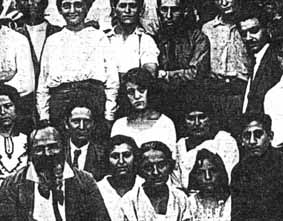
|

|
|
|
|
|
|
| file: THE JEWISH COMMUNITY
OF THESSALONIKI (SALONIKA)
RETURN TO Kol haKEHILA Online HOME PAGE Salonika
artist Yehuda Cohen by
Yona Gal
- 11.00
|
 |
| Yehuda Cohen was born in
Salonika on January 19, 1897, to parents of Sephardi origin. Part of his
family originated in Vilna, however, so that he grew up in a mixed Sephardi
- Yiddish atmosphere. His father, Ya’akov, was an engraver. Yehuda studied
at a Talmud Torah. He was active in youth movements, and helped distribute
Zionist newspapers. He served in the army during World War I. In 1919, Yehuda immigrated to Palestine on his own. He settled in Jerusalem, where he was one of 60 students at the Bezalel Art Academy. Yehuda was a brilliant and popular student, one of the most gifted in the academy, and his teachers admired his talent as a painter. Professor Boris Schatz, director of Bezalel, called him "my best student" and had great hopes for his future. Yehuda lived in poverty. Occasionally he would sell one of his drawings and buy flour and salt so that he could bake bread. He dealt with his financial difficulties with his mild manner, his sense of humor, and his satisfaction at being among the pioneers of Hebrew art. In 1923, he held his first exhibition, organized by Professor Schatz at Bezalel. His paintings depicted Biblical scenes, the life of the pioneers, and labor in the Land of Israel. The Biblical stories of his childhood provided inspiration for his creative soul. Yehuda felt that he needed to gain further expertise in painting, and left for Paris in 1923 together with Ze’ev Raban. A year later he returned to Jerusalem. In 1925, he returned to Paris, this time with his friend Madim Zarodinsky (who also perished in the Holocaust). Some time later they reached Italy. Yehuda fell in love with the city of Florence, and remained there for some time. He later returned to Paris, and then moved to Belgium and lived in Brussels for two years. In 1931, Yehuda exhibited paintings at the International Colonial Exhibition in Paris. His paintings appeared in the Land of Israel display. His painting Figures in the Jerusalem Market made a strong impression on many viewers. A year later, two of his pictures, entitled How? and My Room, were shown at another exhibition; both received enthusiastic critical acclaim. On November 7, 1942, at three o’clock in the morning, three policemen came to Yehuda’s apartment in Paris. They took him, his wife, their two daughters, and his father-in-law, Rabbi Yosef Nachmias. His wife Rachel was sick; she was dragged from the apartment and taken by ambulance to Drancy camp, where she died. Yehuda and his family were deported from Drancy on November 11, 1942. On November 13, 1942 they arrived in Auschwitz, where the entire family perished. If any of our readers have information on the artist Yehuda Cohen, please contact Kol haKEHILA or Yona Gal at: eli-gal@internet-zahav.net. Yona Gal is the Seminars Coordinator of the International School for Holocaust Studies at Yad Vashem, Jerusalem. |
|
Copyright: Kol haKEHILA 2000.
All rights reserved. mail to: KOL haKEHILA |